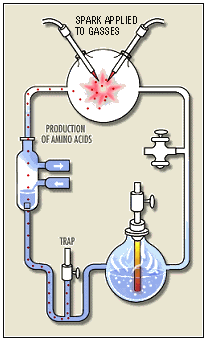
Primer: Origin of Life in a Nutshell Because Neo-Darwinism posits a naturalistic explanation for life, a chemical origin is an essential part of the theory. However, this hypothesis necessitates two insurmountably implausible events: 1) the chemical building blocks of life must form spontaneously and 2) the information that is contained within DNA, RNA and protein must somehow be infused into the chemicals. Because Neo-Darwinism posits a naturalistic explanation for life, a chemical origin is an essential part of the theory. However, this hypothesis necessitates two insurmountably implausible events: 1) the chemical building blocks of life must form spontaneously and 2) the information that is contained within DNA, RNA and protein must somehow be infused into the chemicals.
In answer to the first issue, some scientists and textbooks claim that amino acids, nucleotides, and other “building blocks of life” (pre-biotics) were present on the early earth in a “primordial soup.” However, geological evidence indicates there never was a “primordial soup.” The famous "Miller-Urey Experiment" (see graphic at right from http://science.msfc.nasa.gov/headlines/images/comet-seeds/anim.htm) did produce some amino acids (building blocks of proteins) by sparking gases in a closed system, but they did not use the gases that were present in the earth’s atmosphere, not to mention that early earth was an open system. When the correct gases are used, very few or no amino acids or other building blocks are created. Even if amino acids were formed, they would be both left- and right-handed, making it unclear how life manages to only use left-handed amino acids. Some scientists proposed that the building blocks came from space, but later studies have shown that organic material would be heated and destroyed upon entering the earth’s atmosphere. The naturalistic explanation for the second problem—the origin of the information contained in the polymerized amino acids or nucleotides—is even more elusive. Scientists have explored the possibility that the monomers have intrinsic bonding preferences, but they do not, and if they did, this would not lead to information. Others have suggested that life formed on the back of a crystal or that the first life was RNA-based. But these explanations do not explain the origin of information. In fact, there is no known natural explanation for how or why monomers would form complex information-containing proteins, RNA, or DNA. The only known source of such information is intelligence.
|
Other Nutshells: | |||||||